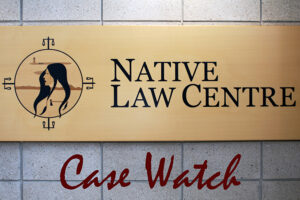Application granted. Blueberry River First Nations is not subject to paying the hearing fees regime in this trial. The Court grants a declaration that Item 10 of Schedule 1 in Appendix C of the Supreme Court Civil Rules is of no force and effect insofar as it requires Indigenous peoples who are seeking to uphold or protect their s 35(1) Aboriginal and/or treaty rights from alleged infringements, and who are required to do so through a trial, to pay daily hearing fees to the Crown as the defendant in any such action. If this Court is wrong in reading down the hearing fee provision in the way set out above, then it would exercise its discretion contained in Item 10 of Schedule 1 in Appendix C to order the Crown to pay the hearing fees in this action.
This application arises in the context of an action brought by the Blueberry River First Nations [“Blueberry”] against Her Majesty the Queen in Right of the Province of British Columbia [“Crown”] alleging infringements of their rights under Treaty 8. It addresses the cumulative impacts of a variety of Crown authorized activities occurring in their traditional territory. In this application, Blueberry seeks to be relieved from paying the daily hearing fees prescribed by the Supreme Court Civil Rules [“Rules”] and set out in Appendix C, Schedule 1, at Item 10 for the duration of the trial of the underlying action.
The underlying trial is currently set for 160 days. For Blueberry, that means paying over $120,000 in hearing fees to the Crown. Rule 20-5(1) provides for a waiver of fees in certain circumstances. Blueberry seeks an order under Appendix C, Schedule 1, Item 10 of the Rules that the Crown defendant pay the daily hearing fees; or, in the alternative, a constitutional exemption from paying the hearing fees based on s 35(1) of the Constitution Act, 1982; or, if necessary, a declaration that the hearing fees are constitutionally inapplicable under s 52(1) of the Constitution Act, 1982 to the extent they are inconsistent with s 35(1). They do not seek a waiver of fees based on undue hardship under Rule 20-5(1).
The Crown, as the defendant in this s 35(1) treaty rights claim, cannot charge the plaintiff First Nations substantial fees for access to the court to seek to enforce the Crown’s own treaty obligations. This, Blueberry argues, is inconsistent with the honour of the Crown and the Crown’s duties under s 35(1) to promote reconciliation.
Reconciliation takes place both inside and outside the courtroom. While consultation and negotiation are the primary methods of reconciliation, courts also have a role to play. The parties will not always be able to resolve the issues, and courts will be called on to determine rights and the attaching obligations. In the Aboriginal context, when considering statutes or rules that may bar, prevent or impede Indigenous peoples’ ability to pursue their claims, reconciliation must weigh heavily in the balance (Manitoba Métis Federation Inc v Canada (AG), [2013] 2 CNLR 281).
None of the cases relied on by the Crown dealt with s 35(1) in the context of hearing fees, or considered the impacts on Crown-Indigenous relations, the honour of the Crown, or reconciliation more broadly from charging such fees. This is the first case to consider the constitutionality of hearing fees from that perspective.
This Court does not agree with the Crown’s argument that recognizing the uniqueness of s 35(1) rights, and relieving litigants who seek to advance these rights of the obligation to pay hearing fees, would somehow be establishing a preferential system of access to justice. The charge of a substantial fee, which ultimately is for the Crown’s own benefit, to access the court to seek to uphold a constitutionally protected treaty right is antithetical to the purpose of s 35(1), the principle of honour of the Crown, and the objective of reconciliation. The fee creates an additional obstacle for Indigenous litigants whose claims often require long trials. It is apparent that requiring litigants who are pursuing cases dealing with s 35(1) to pay a hearing fee is in effect an advance that is paid by Indigenous peoples.
The requirement to pay daily hearing fees creates inequality in litigation in these circumstances and is inconsistent with the shared responsibility for reconciliation which is the overarching objective of s 35(1). The fees create unfairness, imposes financial obstacles to litigation (which can become significant in long trials), and reinforces the idea that the promise in s 35 still comes with strings attached. The Court can draw a legitimate distinction for Indigenous peoples in these circumstances based on the Crown’s unique obligation to Aboriginal people, and the unique status of Aboriginal and treaty rights in the Constitution Act, 1982.



